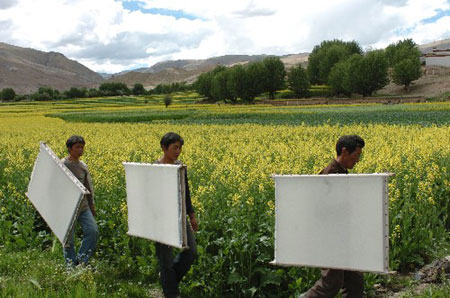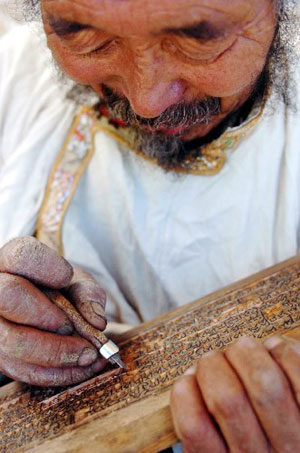Nyemo County, birth place of the Tibetan language, is renowned for "three treasures" -- Tibetan paper, engraving and incense.
Nyemo Paper
As early as 640 AD, the Nyemoers began to make paper from the roots of Herba Gelsemii Elegantis, a local plant containing poisonous ingredients that can keep moth and mice away.

Photo taken on July 2, 2005 shows villagers in Tarong Township, Nyemo County, Lhasa, taking dried Tibetan paper back to their homes, photo from Xinhua.
With special hand-only techniques of six courses, the paper has such good durability that it could be long preserved. That's why it usually serves as the principal writing material for Buddhist scriptures.
Meanwhile, the demand to print large number of Buddhist sutras also pushed the expansion of this traditional papermaking technique, which is always passed on by generation in a family.
Families engaged in the Tibetan papermaking in Nyemo county have reduced from 16 households before 1949 to one now.
Having developed into a special craft, the Nyemo Tibetan papermaking has been protected as an intangible cultural heritage.
Pusum Engraving
Pusum, Nyemo County, is the town of engraving. The engraved plates, with figures or pictures on, are frequently used in the Tibetan Buddist rituals.

Photo taken on July 4, 2005 shows farmers drying the Tibetan incenses in Tomba Township, Nyemo County, Lhasa, capital of southwest China's Tibet Autonomous Region, photo from Xinhua.
Now, as a popular tourist souvenir, the Pusum engraving has widened its content from religion, figure, and landscape to various aspects in society.
There are 600 farmers and herdsmen embarking in carving and related work, accounting for 28.73 percent of the entire population of the township.
Nyemo incense
Making use of the local natural resources -- adequate water supply, favorable climate and various plants, villagers in Tomba Township, Nyemo County, have been specializing in Tibetan incense production with a history of more than 1,000 years.

Villager Qampen in Nyemo County carves a plate on June 4, 2005. Engraving, incense and Tibetan paper are considered as the three treasures in Nyemo, photo from Xinhua.
Today, this fragrant incense has a dozen varieties and is widely used on many occasions.
Though such incense often serves sacrificial ceremonies, it also can be used to prevent infectious diseases like flu and influenza, for its ingredients contain herbal medicines such as saffron, Sandalwood, Chinese Usnea and borneol.
